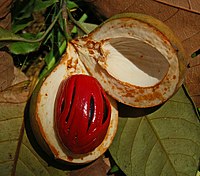
Photo from wikipedia
Cotton is one of the most important economic crops and its production is influenced by various adverse factors. Boll shedding at an inappropriate period causes the severe loss of cotton… Click to show full abstract
Cotton is one of the most important economic crops and its production is influenced by various adverse factors. Boll shedding at an inappropriate period causes the severe loss of cotton yield. Ethephon can promote the formation of abscission layer cells, resulting in boll shedding. To genome-widely investigate the differentially expressed miRNAs involved in the formation of abscission layer cells, two sRNA libraries were constructed using abscission tissues of cotton pedicels treated with ethephon or water. A total of 55,264,755 and 59,069,866 clean reads were generated in two libraries. 460 mature miRNAs were identified, including 301 known miRNAs and 159 novel miRNAs. Among them, one known gra-MIR530b and seven novel miRNAs (gar-novel-miR88-3p/gra-novel-miR8-3p, gar-novel-miR16-5p, gar-novel-miR100-3p, gar-novel-miR75-3p/gra-novel-miR92-3p,gar-novel-miR32-5p/gra-novel-miR30-5p, gar-novel-miR9-5p and gra-novel-miR61-3p) were expressed differentially in abscission tissues. Seven-two genes were predicted as potential targets of the eight miRNAs. Gene ontology (GO) analyses revealed that most of these target genes are auxin response factors (ARFs), GTPase activators, and the regulators of oxidative phosphorylation and photosynthesis. Hence, we speculate that these miRNAs might regulate cell separation and aging to affect the formation of bscission layer cells. Our findings will provide a new insight into the regulatory mechanism of miRNAs involved in boll shedding.
Journal Title: Gene
Year Published: 2018
Link to full text (if available)
Share on Social Media: Sign Up to like & get
recommendations!